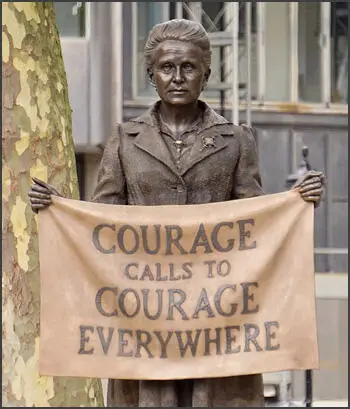On this day on 10th May
On this day in 1872 Victoria Woodhull becomes the first woman nominated for President of the United States as the candidate of the Equal Rights Party. Although laws prohibited women from voting, there was nothing stopping women from running for office. Woodhull suggested that Frederick Douglass should become her running partner but he declined the offer.
During the campaign Woodhull called for the "reform of political and social abuses; the emancipation of labor, and the enfranchisement of women". Woodhull also argued in favour of improved civil rights and the abolition of capital punishment. These policies gained her the support of socialists, trade unionists and women suffragists. However, conservative leaders of the American Woman Suffrage Association, such as Susan Anthony and Elizabeth Cady Stanton, were shocked by some of her more extreme ideas and supported Horace Greeley in the election.
Friends of President Ulysses Grant decided to attack Victoria Woodhull's character and she was accused of having affairs with married men. It was also alleged that Victoria's previous husband was an alcoholic and her her sister, Utica Claflin, took drugs. Woodhull became convinced that Henry Ward Beecher was behind these stories and decided to fight back. She now published a story in the Woodhull and Claflin's Weekly that Beecher was having an affair with a married woman.
Woodhull was arrested and charged under the Comstock Act for sending obscene literature through the mail and was in prison on election day. (Woodhull's name did not appear on the ballot because she was one year short of the Constitutionally mandated age of thirty-five.) Over the next seven months Woodhull was arrested eight times and had to endure several trials for obscenity and libel. She was eventually acquitted of all charges but the legal bills forced her into bankruptcy.
In 1878 Woodhull moved to England. She continued to campaign for women's rights and in 1895 she established the Humanitarian newspaper. In 1897 she gave up publishing and moved to Bredon's Norton, where she built a village school and became a champion for education reform in English schools.
Victoria Woodhull died on 9th June, 1927.
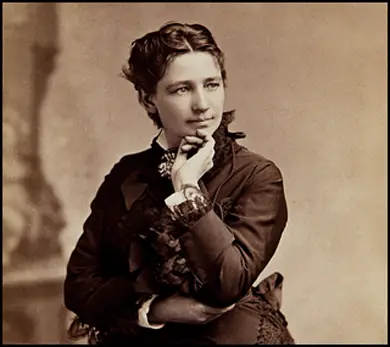
On this day in 1886 philosopher Karl Barth, the son of a minister of the Swiss Reformed Church, was born in Basle on 10th May, 1886. He studied theology in Berlin, Tubinggen and Marburg. In 1913 Barth married Nelly Hoffman and over the next few years the couple had five children. In 1919 Barth published Epistle to the Romans.
Barth became professor of theology at Gottingen (1921-25) and Munster (1925-30). In 1930 he was appointed professor at theology at Bonn University. While in Germany he joined forces with Martin Niemöller and Dietrich Bonhoffer to establish what became known as the Confessional Church.
A committed socialist, Barth was the leading figure behind the Barmen Declaration in 1934. This statement explained why Christians should oppose the policies of the Nazi Party. Barth lost his post at Bonn University when he refused to take an unconditional oath to Adolf Hitler. He now returned to Switzerland and in 1935 became professor of theology at Bonn University.
Books by Barth include The Word of God and the Word of Man (1924), Credo (1935), Knowledge of God and the Service of God (1938), Evangelical Theology (1962) and several volumes of Church Dogmatics (1932-67).
Karl Barth died on 10th December 1968.
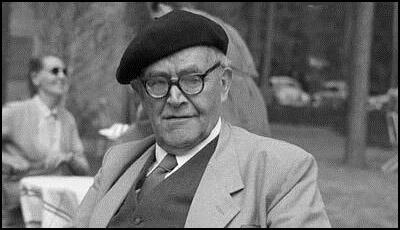
On this day in 1901 John Desmond Bernal (always known as J. D. Bernal) was born in Nenagh, Ireland. He was educated at Stonyhurst College, Lancashire and Emmanuel College, Cambridge.
In 1923 Bernal joined the Communist Party. Greatly influenced by the work of John Haldane, the two men joined Julian Huxley, and seventeenother British scientists on a visit to the Soviet Union in 1931. While there they had meetings with Nickolai Bukharin and other government leaders.
Bernel's research helped developed modern crystallography and he was a founder of molecular biology. He eventually became professor of physics at Cambridge University and in 1932 worked on the development of X-ray crystallography with Dorothy Hodgkin. Over the next four years Hodgkin and Bernal produced 12 joint crystallographic papers. Bernal left the Communist Party in 1934 but he continued to be active in left-wing politics.
In 1937 Bernal became professor of crystallography at Birkbeck College. Bernal wrote several books on Marxism and science. This included the Social Function of Science (1939) and Marx and Science (1952).
During the Second World War Bernal was scientific adviser to Lord Mountbatten. He carried out several research projects for the government. This included working with Solly Zuckerman on the impact of bombing on people and buildings.
Tom Hopkinson met Bernel during this period: "J. D. Bernal, a professor at Birkbeck College known to his friends as Sage, partly because of his vast fund of knowledge and partly on account of his enormous head with its shock of wavy hair. Sage had now teamed up with another still more celebrated young professor, Solly Zuckerman, best known at that time for his studies of apes. During the course of the war they would together undertake a whole series of important assignments, but at this moment they were looking into the precise effects of bombing both on people and on buildings, into which it seemed very little research had previously been carried out. Their immediate concern was a casualty survey for which they would travel up and down the country to wherever some incident appeared to demand investigation, and I listened fascinated while they told me what they were doing."
Herbert Butterfield argued: "Bernal was a big man of captivating charm who certainly influenced hundreds of undergraduates. He was that rare creature, a person of truly seminal ideas on a host of subjects, yet one who would never have exercised the cumulative persistence with detail required to win a Nobel Prize. I liked Bernal enormously."
In August 1943 he attended the Quebec Conference and helped to select the landing beachers for the D-Day invasion of France. In the 1940s Bernal began living with Margot Heinemann and gave birth to a daughter, Jane Bernal.
In 1947 Bernal was awarded the US Medal of Freedom. However, his left-wing views made him an unwanted guest during McCarthyism and the US government refused to let him have an American visa. Bernal became vice-president of the World Peace Committee and in 1951 founded Scientists for Peace, the forerunner of the Campaign for Nuclear Disarmament (CND)..
Along with Rosalind Franklin Bernel carried out research into the tobacco mosaic virus (1953-58). Bernal continued to publish books and this included The Origin of Life (1967).
J. D. Bernal died on 15th September 1971
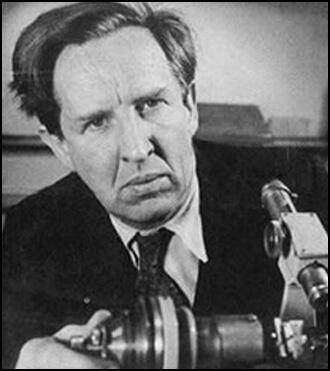
On this day in 1915 the The Times reported the Germans had crucified a Canadian officer: "Last week a large number of Canadian soldiers wounded in the fighting round Ypres arrived at the base hospital at Versailles. They all told the story of how one of their officers had been crucified by the Germans. He had been pinned to a wall by bayonets thrust through his hands and feet, another bayonet had then been driven through his throat, and, finally, he was riddled with bullets. The wounded Canadians said that the Dublin Fusiliers had seen this done with their own eyes, and that they had heard the officers of the Dublin Fusiliers talking about it."
The following day The Toronto Star published an interview with C. J. Clayton, who was serving with the British Red Cross. He told the story of how Captain R. A. Allen of the 5th Canadian Battalion had told him before he died of his wounds that he had witnessed the crucifixion of a Canadian sergeant by the German Army in France: "Allen went on to declare that he and a medical officer, major, and others all signed a sworn statement attesting the truth of a detailed record of the crucifixion. A Canadian sergeant was tied up by the arms and legs to a tree and pierced sixty times by German bayonets."
The Morning Post also reported this story: "Wounded Canadians here are all certain that the enemy is particularly vindictive towards them, as the Germans have been furious that the Canadians did not stay in Canada instead of coming over to help England. The Canadians are all firmly of the belief that a Canadian soldier was crucified. They assert they heard it from officers in the Dublin Fusiliers who actually came across the body nailed to a door with hands and feet pierced with bayonets. The body was riddled with bullets."
Dalton Trumbo read about the crucified Canadian soldier in newspapers in Los Angeles: "The Los Angeles newspapers carried a story of two young Canadian soldiers who had been crucified by the Germans in full view of their comrades across No Man's Land. That made the Germans nothing better than animals, and naturally you got interested and wanted Germany to get the tar kicked out of her."
The Times returned to the story on 15th May, where it identified the crucifixion taking place in Ypres in April, 1915: "The story.... of the crucifixion of a Canadian officer during the fighting at Ypres on April 22-23 is in substance true. The story was current here at the time, but, in the absence of direct evidence and absolute proof, men were unwilling to believe that a civilized foe could be guilty of an act so cruel and savage. Now, I have reason to believe, written depositions testifying to the fact of the discovery of the body are in possession of the British Headquarter Staff. The unfortunate victim was a sergeant. As the story was told to me, he was found transfixed to the wooden fence of a farm building. Bayonets were thrust through the palms of his hands and feet, pinning him to the fence. He had been repeatedly stabbed with bayonets, and there were many punctured wounds in his body."
Despite these reports the story was never verified by an official source. Brigadier-General John Charteris, the Chief Intelligence Officer at GHQ, later wrote about how the story originated: "The story... began in a report sent by a sergeant that he had seen Germans sitting round a lighted fire, and what looked like a crucified man. He worked his way closer to them, and found that it was only shadows cast by some crossed sticks on other objects. The report was transmitted back without this explanation." It is now believed that the story of the crucified Canadian soldier was part of Charteris's black propaganda campaign that also included the Angel of Mons, the German Corpse Factory and Belgian Civilian Atrocities stories.
Paul Fussell argued in The Great War and Modern Memory (1975): "Another well-known rumor imputing unique vileness to the Germans is that of the Crucified Canadian. The usual version relates that the Germans captured a Canadian soldier and in full view of his mates exhibited him in the open spread-eagled on a cross, his hands and feet pierced by bayonets. He is said to have died slowly. Maple Copse, near Sanctuary Wood in the Ypres sector, was the favorite setting... The Crucified Canadian is an especially interesting fiction both because of its original context in the insistent visual realities of the front and because of its special symbolic suggestiveness. The image of crucifixion was always accessible at the front because of the numerous real physical calvaries visible at French and Belgian crossroads, many of them named Crucifix Corner."
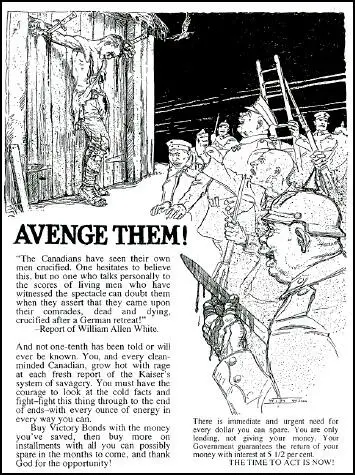
On this day in 1924 J. Edgar Hoover is appointed first Director of the Bureau of Investigation. The three years that he had spent in the organization had convinced Hoover that the organization needed to improve the quality of its staff. Great care was spent in recruiting and training agents. In 1926 Hoover established a fingerprint file that eventually became the largest in the world.
The power of the bureau was limited. Law enforcement was a stare activity, not a federal one. Hoover's agents were not allowed to carry guns, nor did they have the right to arrest suspects. Hoover complained about this situation and in 1935 Congress agreed to establish the Federal Bureau of Investigation (FBI). Agents were now armed and could act against crimes of violence throughout the United States.
Hoover now set about establishing a world-class crime fighting organization. Innovations introduced by Hoover included the formation of a scientific crime-detention laboratory and the highly regarded FBI National Academy. Hoover appointed Clyde Tolson as Assistant Director of the FBI. In his book, The Secret Life of J. Edgar Hoover (1993), Anthony Summers claims that Hoover and Tolson became lovers. For the next forty years the two men were constant companions. In the FBI the couple were known as "J. Edna and Mother Tolson". Mafia boss, Meyer Lansky, obtained photographic evidence of Hoover's homosexuality and was able to use this to stop the FBI from looking too closely into his own criminal activities.
During the Spanish Civil War Hoover arranged for FBI agents to report on those Americans that fought for the Abraham Lincoln Battalion and George Washington Battalion. Hoover later wrote: "When a civil war broke out in that country in 1936, the Communists acted in line with the theory that the Soviet Union should be used as the base for the extension of Communist control over other countries. Soviet intervention in the Spanish civil war was twofold in nature. First, in response to directions from the Comintern, the international Communist movement organized International Brigades to fight in Spain. A typical unit was the Abraham Lincoln Brigade, organized in the United States... Many Communists throughout the world who answered the Comintern's call to fight in Spain were repaid subsequently by Soviet assistance in their attempts to seize power in their respective countries."
When the journalist, Ray Tucker, hinted at Hoover's homosexuality in an article for Collier's Magazine, he was investigated by the Federal Bureau of Investigation. Information about Tucker's private life was leaked to the media and when this became known, other journalists were frightened off from writing about this aspect of Hoover's life.
President Franklin D. Roosevelt enjoyed a good relationship with Hoover. Roosevelt's attorney general, Robert Jackson commented, "The two men liked and understood each other." Roosevelt asked Hoover to investigate Charles Lindbergh, one of the leaders of the American First Committee. He willingly did so for he had been upset by Lindbergh's critical comments about the failures of the FBI investigation into the kidnapping and murder of his infant son. He also provided detailed reports on isolationists such as Burton K. Wheeler, Gerald Nye and Hamilton Fish.
Roosevelt wrote to Hoover thanking him for this information. "I have intended writing you for some time to thank you for the many interesting and valuable reports that you have made to me regarding the fast moving situations of the last few months." Hoover replied on 14th June, 1940: "The letter is one of the most inspiring messages which I have ever been privileged to receive; and, indeed, I look upon it as rather a symbol of the principles for which our Nation stands. When the President of our country, bearing the weight of untold burdens, takes the time to express himself to one of his Bureau heads, there is implanted in the hearts of the recipients a renewed strength and vigor to carry on their tasks."
Hoover persuaded Franklin D. Roosevelt to give the FBI the task of investigating both foreign espionage in the United States. This included the collection of information on those with radical political beliefs. After Elizabeth Bentley, a former member of the American Communist Party, provided the FBI with information about a Soviet spy ring in 1945, Hoover became convinced that that their was a communist conspiracy to overthrow the United States government.
When checked, much of the information provided by Elizabeth Bentley was found to be untrue. However, by intimidating the people that Bentley had named, the FBI were able to obtain the information needed to convict Harry Gold, David Greenglass, Ethel Rosenberg and Julius Rosenberg of spying.
Hoover believed that several senior officials in the government were secret members of the Communist Party. Unhappy with the way Harry S. Truman, responded to this news, Hoover began leaking information about officials such as Alger Hiss to those politicians that shared his anti-communist views. This included Joseph McCarthy, John S. Wood, John Parnell Thomas, John Rankin and Richard Nixon. Hoover was a great supporter of the House of Un-American Activities Committee (HUAC), an organisation that relieved heavily on information provided by the FBI.
Hoover was particularly concerned with the political influence that television and the cinema was having on the people of the United States. He encouraged the House of Un-American Activities Committee investigation into the entertainment industry and the decision by the major media networks to blacklist artists who were known to hold left of centre political views.
In June, 1950, three former FBI agents published Red Channels, a pamphlet listing the names of 151 writers, directors and performers who they claimed had been members of subversive organizations before the Second World War but had not so far been blacklisted. The names had been compiled from FBI files and a detailed analysis of the Daily Worker, a newspaper published by the American Communist Party.
A free copy of Red Channels was sent to those involved in employing people in the entertainment industry. All those people named in the pamphlet were blacklisted until they appeared in front of the House of Un-American Activities Committee (HUAC) and convinced its members they had completely renounced their radical past. By the late 1950s it was estimated that over 320 artists had been blacklisted and were unable to find work in television and the cinema.
Hoover became friends with Clint Murchison and Sid Richardson, became friends of J. Edgar Hoover, the head of the Federal Bureau of Investigation. It was the start of a long friendship. According to Anthony Summers, the author of The Secret Life of J. Edgar Hoover (1993): "Recognizing Edgar's influence as a national figure, the oilmen had started cultivating him in the late forties-inviting him to Texas as a houseguest, taking him on hunting expeditions. Edgar's relations with them were to go far beyond what was proper for a Director of the FBI."
Hoover and Clyde Tolson were regular visitors to Murchison's Del Charro Hotel in La Jolla, California. The three men would visit the local racetrack, Del Mar. Allan Witwer, the manager of the hotel at the time, later recalled: "It came to the end of the summer and Hoover had made no attempt to pay his bill. So I went to Murchison and asked him what he wanted me to do." Murchison told him to put it on his bill. Witwer estimates that over the next 18 summers Murchison's hospitality was worth nearly $300,000. Other visitors to the hotel included Richard Nixon, John Connally, Lyndon B. Johnson, Meyer Lansky, Santos Trafficante, Johnny Rosselli, Sam Giancana and Carlos Marcello.
In 1952 Hoover and Murchison worked together to mount a smear campaign against Adlai Stevenson, the Democratic Party candidate for the presidency. Hoover and Tolson, also invested heavily in Murchison's oil business. In 1954 Murchison joined forces with Sid Richardson and Robert Ralph Young to gain control of the New York Central Railroad. This involved buying 800,000 shares worth $20 million.
In 1953 Hoover asked one of his senior agents, Cartha DeLoach to join the American Legion to "straighten it out". According to the journalist, Sanford J. Ungar, he took the assignment so seriously that he became national vice-commander of the organization: "DeLoach became chairman of the Legion's national public relations commission in 1958 and in that position and in his other Legion offices over the years, he exercised a great deal of influence over the organization's internal policies as well as its public positions."
DeLoach became an important figure in Hoover's FBI. This included working closely with Lyndon B. Johnson. It was DeLoach who arranged with Johnson, who was the Senate majority leader, to push through legislation guaranteeing Hoover a salary for life. DeLoach later recalled: “There was political distrust between the two of them, but they both needed each other." However, he denied that the two men worked together to blackmail politicians. In his book, Hoover's FBI (1995), DeLoach argued: "The popular myth, fostered of late by would-be historians and sensationalists with their eyes on the bestseller list, has it that in his day J. Edgar Hoover all but ran Washington, using dirty tricks to intimidate congressmen and presidents, and phone taps, bugs, and informants to build secret files with which to blackmail lawmakers." According to DeLoach this was not true.
In 1958 Clint Murchison purchased the publishers, Henry Holt and Company. He told the New York Post: "Before I got them, they published some books that were badly pro-Communist. They had some bad people there.... We just cleared them all out and put some good men in. Sure there were casualties but now we've got a good operation." One of the first book's he published was by his old friend, J. Edgar Hoover. The book, Masters of Deceit: The Story of Communism in America (1958), was an account of the Communist menace and sold over 250,000 copies in hardcover and over 2,000,000 in paperback. It was on the best-seller lists for thirty-one weeks, three of them as the number one non-fiction choice.
William Sullivan was ordered to oversee the project, claimed that as many as eight agents worked full-time on the book for nearly six months. Curt Gentry, the author of J. Edgar Hoover: The Man and the Secrets (1991) points out Hoover claimed that he intended to give all royalties to the FBI Recreational Association (FBIRA). However, he claims that the "FBIRA was a slush fund, maintained for the use of Hoover, Tolson, and their key aides. It was also a money-laundering operation, so the director would not have to9 pay taxes on his book royalties." Gentry quotes Sullivan as saying that Hoover "put many thousands of dollars of that book.... into his own pocket, and so did Tolson."
Ronald Kessler, the author of The Bureau: The Secret History of the FBI (2002) DeLoach was involved in blackmailing Senator Carl T. Hayden, chair of the Senate Rules and Administration Committee, into following the instructions of Hoover. In April 1962, Roy L. Elson, Hayden's administrative assistant, questioned Hayden's decision to approve the $60 million cost of the FBI building. When he discovered what Elson was saying, DeLoach "hinted" that he had "information that was unflattering and detrimental to my marital situation... I was certainly vulnerable that way... There was more than one girl... The implication was there was information about my sex life... I interpreted it as attempted blackmail."
FBI Special Agent Arthur Murtagh also testified that Cartha DeLoach was involved in the blackmail of politicians on government committees. He claimed that DeLoach told him: "The other night, we picked up a siuation where this senator was seen drunk, in a hit-and-run accident, and some good-looking broad was with him. We got the information, reported it in a memorandum, and by noon the next day, the senator was aware that we had the information, and we never had trouble with him on appropriations since."
Hoover and the FBI carried out detailed investigations into any prominent person who he thought held dangerous political views. This included leaders of the civil rights movement and those opposed to the Vietnam War. At the same time Hoover virtual ignored organized crime and his investigations into political corruption was mainly used as a means of gaining control over politicians in powerful positions. In 1959 Hoover had 489 agents spying on communists but only 4 investigating the Mafia. As early as 1945 Harry S. Truman complained how Hoover and his agents were "dabbling in sex life scandals and plain blackmail when they should be catching criminals".
J. Edgar Hoover received information that President John F. Kennedy was having a relationship with Ellen Rometsch. In July 1963 Federal Bureau of Investigation agents questioned Romesch about her past. They came to the conclusion that she was probably a Soviet spy. Hoover actually leaked information to the journalist, Courtney Evans, that Romesch worked for Walter Ulbricht, the communist leader of East Germany. When Robert Kennedy was told about this information, he ordered her to be deported.
The FBI had discovered that there were several women at the Quorum Club who had been involved in relationships with leading politicians. This included both John F. Kennedy and Robert Kennedy. It was particularly worrying that this included Mariella Novotny and Suzy Chang. This was a problem because they both had connections to communist countries and had been named as part of the spy ring that had trapped John Profumo, the British war minister, a few months earlier. President Kennedy told J. Edgar Hoover that he "personally interested in having this story killed".
Hoover refused and leaked the information to Clark Mollenhoff. On 26th October he wrote an article in The Des Moines Register claiming that the FBI had "established that the beautiful brunette had been attending parties with congressional leaders and some prominent New Frontiersmen from the executive branch of Government... The possibility that her activity might be connected with espionage was of some concern, because of the high rank of her male companions". Mollenhoff claimed that John Williams "had obtained an account" of Rometsch's activity and planned to pass this information to the Senate Rules Committee.
Hoover developed a close relationship with Lyndon B. Johnson. The two men shared information that they had on senior politicians. After the assassination of John F. Kennedy, Hoover helped Johnson to cover-up the assassination and the Bobby Baker scandal. In an interview Cartha DeLoach gave in 1991 he claimed: "Mr. Hoover was anxious to retain his job and to stay on as director. He knew that the best way for the F.B.I. to operate fully and to get some cooperation of the White House was for him to be cooperative with President Johnson... President Johnson, on the other hand, knew of Mr. Hoover’s image in the United States, particularly among the middle-of-the-road conservative elements, and knew it was vast. He knew of the potential strength of the F.B.I. - insofar as being of assistance to the government and the White House is concerned. As a result it was a marriage, not altogether of necessity, but it was a definite friendship caused by necessity.”
William Sullivan was the FBI's third-ranking official behind Hoover and Clyde A. Tolson. Sullivan was placed in charge of FBI's Division Five. This involved smearing leaders of left-wing organizations. Sullivan was a strong opponent of the leadership of Martin Luther King. In January, 1964, Sullivan sent a memo to Hoover: "It should be clear to all of us that King must, at some propitious point in the future, be revealed to the people of this country and to his Negro followers as being what he actually is - a fraud, demagogue and scoundrel. When the true facts concerning his activities are presented, such should be enough, if handled properly, to take him off his pedestal and to reduce him completely in influence." Sullivan's suggested replacement for King was Samuel Pierce, a conservative lawyer who was later to serve as Secretary of Housing under President Ronald Reagan.
FBI agent Arthur Murtagh was involved in the campaign against the civil rights movement: "He was brought up in a culture... in that society there was a real sense of belief, a religious belief, political belief, that there was no such thing as equality between blacks and whites, and that's the way he viewed them... Hoover did so many things to discredit the civil rights movement that I hardly know where to start. In the first place, he put about the same emphasis... much more of the facilities of the Bureau toward keeping the Klan... keeping the blacks in place and let the Klan run wild. He was friendly with people in the South, and ... when a situation came up, he would always make his decisions in favor of the local people."
William Sullivan disagreed with J. Edgar Hoover about the threat to national security posed by the American Communist Party and felt that the FBI was wasting too much money investigating this group. On 28th August, 1971, Sullivan sent Hoover a long letter pointing out their differences. Sullivan also suggested that Hoover should consider retirement. Hoover refused and it was Sullivan who had to leave the organization.
The FBI under Hoover collected information on all America's leading politicians. Known as Hoover's secret files, this material was used to influence their actions. It was later claimed that Hoover used this incriminating material to make sure that the eight presidents that he served under, would be too frightened to sack him as director of the FBI. This strategy worked and Hoover was still in office when he died, aged seventy-seven, on 2nd May, 1972.
Clyde Tolson arranged for the destruction of all Hoover's private files. A senate report in 1976 was highly critical of Hoover and accused him of using the organization to harass political dissidents in the United States.
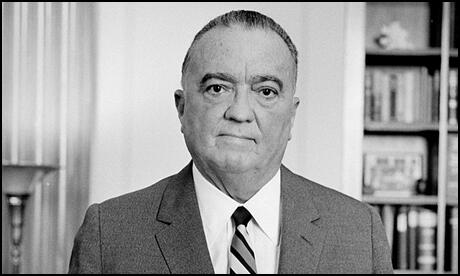
On this day in 1926 John Reith, managing director of the BBC writes in his diary about the General Strike. Several politicians representing the Conservative Party and the Liberal Party, appeared on BBC radio and made vicious attacks on the trade union movement. William Graham, the Labour Party MP for Edinburgh Central, wrote to Reith suggesting that he should allow "a representative Labour or Trade Union leader to state the case for the miners and other workers in this crisis".
Ramsay MacDonald, the leader of the Labour Party, also contacted Reith and asked for permission to broadcast his views. Reith recorded in his diary: "He (MacDonald) said he was anxious to give a talk. He sent a manuscript along... with a friendly note offering to make any alterations which I wanted... I sent it at once to Davidson for him to ask the Prime Minister, strongly recommending that he should allow it to be done." The idea was rejected and Reith argued: "I do not think that they treat me altogether fairly. They will not say we are to a certain extent controlled and they make me take the onus of turning people down. They are quite against MacDonald broadcasting, but I am certain it would have done no harm to the Government. Of course it puts me in a very awkward and unfair position. I imagine it comes chiefly from the PM's difficulties with the Winston lot."
When he heard the news, MacDonald, wrote Reith an angry letter, calling "for an opportunity for the fair-minded and reasonable public to hear Labour's point of view". Anne Perkins, the author of A Very British Strike: 3 May-12 May 1926 (2007) has argued that if the government had accepted the proposal and people had "heard an Opposition voice would certainly have done something to restore the faith of millions of working-class people who had lost confidence in the BBC's potential to be a national institution and a reliable and trustworthy source of news."
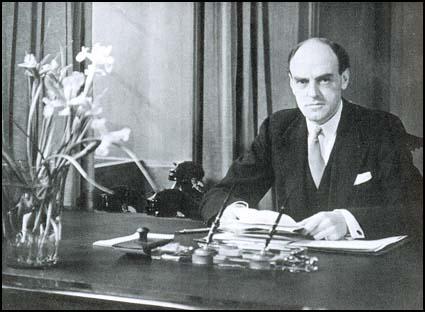
On this day in 1933 the Nazi Party arranged the burning of thousands of "degenerate literary works" were burnt in German cities. This included books by people such as Sigmund Freud, Rosa Luxemburg, August Bebel, Eduard Bernstein, Heinrich Mann, Bertolt Brecht, Helen Keller, H.G. Wells, Ernest Hemingway, Sinclair Lewis, Otto Dix, Victor Hugo, Lenin, Leon Trotsky, Hans Eisler, Ernst Toller, Albert Einstein, D.H. Lawrence, John Dos Passos, Theodore Dreiser, Karl Kautsky, Thomas Heine, Arnold Zweig, Ludwig Renn, Rainer Maria Rilke, Karl Marx, Friedrich Engels, George Grosz, Maxim Gorky and Isaac Babel.
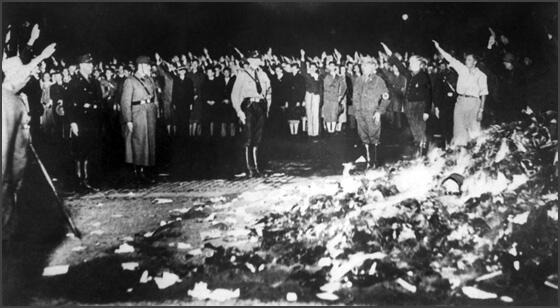
On this day in 1940 Benito Mussolini declared war on Britain. Italians living in Britain were interned. This included 4,000 people with less than twenty years' residence in Britain. This included many Mussolini's left-wing opponents who had fled to Britain after being involved in anti-fascist activities in Italy.
On 12th May, 1940, John Anderson, who was in charge of national security, ordered the arrests of over 2,000 male aliens living in coastal areas. A few days later all 'B' class aliens were rounded up and placed into internment camps. Winston Churchill defended this policy by claiming that it was necessary to "collar the lot".
The Daily Mail, a newspaper that had supported Oswald Mosley and the British Union of Fascists in the 1930s, now led a campaign to have all aliens in Britain interned. Some employers began to sack all foreigners. There were even cases of people losing their jobs because they had foreign ancestors. As one critic of this policy pointed out, this was an argument for removing the British royal family as their ancestors had originally come from Germany. (George V changed the name of the royal family from Saxe-Coburg-Gotha to Windsor as a result of anti-German feeling during the First World War).
Government bodies also became involved in carrying out acts of discrimination against foreigners. Some local authorities turned aliens out of council houses. The Home Guard rejected applications from men with alien parentage or origin. In one case, an English soldier who had won the Victoria Cross during the First World War, was turned down when he tried to join the Home Guard because of his "alien parentage".
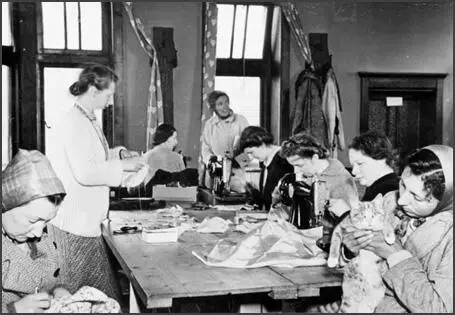
On this day in 1940 Edward Murrow, CBS radio broadcast from London.
History has been made too fast over here today. First, in the early hours this morning, came the news of the British unopposed landing in Iceland. Then the news of Hitler's triple invasion came rolling into London, climaxed by the German air bombing of five nations. British mechanized troops rattled across the frontier into Belgium. Then at nine o'clock tonight a tired old man spoke to the nation from No. 10 Downing Street. He sat behind a big oval table in the Cabinet Room where so many fateful decisions have been taken during the three years that he has directed the policy of His Majesty's government. Neville Chamberlain announced his resignation.
Winston Churchill, who has held more political offices than any living man, is now Prime Minister. He is a man without a party. For the last seven years he has sat in the House of Commons, a rather lonesome and often bellicose figure, voicing unheeded warnings of the rising tide of German military strength. Now, at the age of sixty-five, Winston Churchill, plump, bald, with massive round shoulders, is for the first time in his varied career of journalist, historian and politician the Prime Minister of Great Britain. Mr. Churchill now takes over the supreme direction of Britain's war effort at a time when the war is rapidly moving toward Britain's doorstep. Mr. Churchill's critics have said that he is inclined to be impulsive and, at times, vindictive. But in the tradition of British politics he will be given his chance. He will probably take chances. But if he brings victory, his place in history is assured.
The historians will have to devote more than a footnote to this remarkable man no matter what happens. He enters office with the tremendous advantage of being the man who was right. He also has the advantage of being the best broadcaster in this country. Mr. Churchill can inspire confidence. And he can preach a doctrine of hate that is acceptable to the majority of this country. That may be useful during these next few months. Hitler has said that the action begun today will settle the future of Germany for a thousand years. Mr. Churchill doesn't deal in such periods of time, but the decisions reached by this new prime minister with his boyish grin and his puckish sense of humour may well determine the outcome of this war.
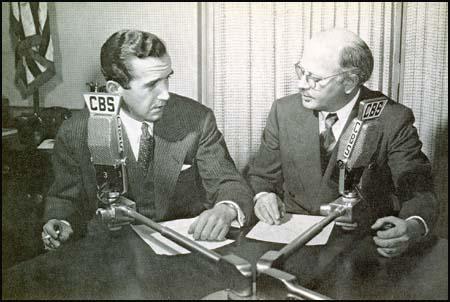
On this day in 1941 Rudolf Hess flew a Me 110 to Scotland. When he parachuted to the ground he was captured by David McLean, of the Home Guard. He asked to be taken to Duke of Hamilton, the “middleman” mentioned in the earlier letter. In fact, Hamilton lived close to where Hess landed (Dungavel House). If Hamilton was the “middleman” who was he acting for. Was it George VI or Winston Churchill? Shortly afterwards Sergeant Daniel McBride and Emyr Morris, reached the scene and took control of the prisoner. Hess’s first words to them were: “Are you friends of the Duke of Hamilton? I have an important message for him.”
After the war Daniel McBride attempted to tell his story of what had happened when he captured Hess. This story originally appeared in the Hongkong Telegraph (6th March, 1947). “The purpose of the former Deputy Fuhrer’s visit to Britain is still a mystery to the general public, but I can say, and with confidence too, that high-ranking Government officials were aware of his coming.” The reason that McBride gives for this opinion is that: “No air-raid warning was given that night, although the plane must have been distinguished during his flight over the city of Glasgow. Nor was the plane plotted at the anti-aircraft control room for the west of Scotland.” McBride concludes from this evidence that someone with great power ordered that Hess should be allowed to land in Scotland. This story was picked up by the German press but went unreported in the rest of the world.
According to Lieutenant-Colonel Malcolm Scott, Hess had told one of his guards that “members of the government” had known about his proposed trip to Scotland. Hess also asked to see George VI as he had been assured before he left Nazi Germany that he had the “King’s protection”. The authors of Double Standards, believe the Duke of Kent, the Duke of Hamilton, Samuel Hoare and Lord Halifax, were all working for the king in their efforts to negotiate with Adolf Hitler.
Karlheinz Pintsch, Hess adjutant, was given the task of informing Hitler about the flight to Scotland. James Leasor found him alive in 1955 and used him as a major source for his book, The Uninvited Envoy. Pintsch told Leasor of Hitler’s response to this news. He did not seem surprised, nor did he rant and rave about what Hess had done. Instead, he replied calmly, “At this particular moment in the war that could be a most hazardous escapade.”
Adolf Hitler then went onto read the letter that Hess had sent him. He read the following significant passage out aloud. “And if this project… ends in failure… it will always be possible for you to deny all responsibility. Simply say I was out of my mind.” Of course, that is what both Hitler and Churchill did later on. However, at the time, Hitler at least, still believed that a negotiated agreement was possible.
Raymond Gram Swing of the Chicago Daily News was invited to Chequers two months after Hess arrived in Scotland. In his autobiography, Good Evening (1964) he explained: "After the meal, the Prime Minister invited me to take a walk with him in the garden. This turned out to be the occasion for an unexpected and, I must say, somewhat disconcerting exposition to me of the terms on which Britain at that time could make a separate peace with Nazi Germany. The gist of the terms was that Britain could retain its empire, which Germany would guarantee, with the exception of the former German colonies, which were to be returned. The timing of this conversation seemed to me significant. Rudolf Hess, the number-three Nazi, had landed by parachute in Scotland less than two months before, where he had attempted to make contact with the Duke of Hamilton, whom the Nazis believed to be an enemy of Mr. Churchill and his policies... Mr. Churchill said nothing to me about Herr Hess. But he expounded to me the advantage of the German terms; and he seemed to be trying to arouse in me a feeling that unless the United States became more actively involved in the war, Britain might find it to her interest to accept them. I may be ascribing to him intentions he did not have. Later I was to learn that Hitler himself had proposed broadly similar terms to Britain before the war actually began. But I was under the impression that the allurements of peace had been recently underlined by Rudolf Hess... But it troubled me to have him give me his exposition, which must have lasted a full twenty minutes. For my part, I believed that the United States's interests made our entry in the war imperative. But I did not believe it would spur the country to come in to be told that if it did not, Winston Churchill would make a separate peace with Hitler and put his empire under a Hitler guarantee of safety."
Eventually Adolf Hitler became convinced that Winston Churchill would refuse to do a deal. Karlheinz Pintsch was now a dangerous witness and he was arrested and was kept in solitary confinement until being sent to the Eastern Front. Hitler also issued a statement pointing out that "Hess did not fly in my name." Albert Speer, who was with Hitler when he heard the news, later reported that "what bothered him was the Churchill might use the incident to pretend to Germany's allies that Hitler was extending a peace feeler."
It was not until 27th January 1942 that Winston Churchill made a statement in the House of Commons about the arrival of Hess. Churchill claimed it was part of a plot to oust him from power and “for a government to be set up with which Hitler could negotiate a magnanimous peace”. If that was the case, were the Duke of Kent and the Duke of Hamilton part of this plot?
In September, 1943, Anthony Eden, the foreign secretary, admitted in the House of Commons that Hess had indeed arrived in Scotland to negotiate a peace settlement. However, Eden claimed that the British government had been unaware of these negotiations. In fact, he added, Hess had refused to negotiate with Churchill. Eden failed to say who Hess was negotiating with. Nor did he explain why Hess (Hitler) was willing to negotiate with someone other than the British government. The authors of Double Standards argue that Hess was negotiating with Duke of Hamilton and the royal family, via the Duke of Kent. It is true Hamilton had a meeting with Churchill and Stewart Menzies two days after Hess arrived in Scotland. We also know that MI6 was monitoring these negotiations. If Hamilton was truly a traitor, surely Churchill would have punished him. Instead, along with the Duke of Kent, who were both in the RAF, were promoted by Churchill. In July 1941 Hamilton became a Group Captain and Kent became an Air Commodore.
This did not stop journalists speculating that the Duke of Hamilton was a traitor. In February 1942, Hamilton sued the London District Committee of the Communist Party for an article that appeared in their journal, World News and Views. The article claimed that Hamilton had been involved in negotiating with Nazi Germany and knew that Hess was flying to Scotland. Had this information come from Kim Philby? The case was settled when the Communist Party issued a public apology. Clearly, they could not say where this information came from.
Later that year Hamilton sued Pierre van Paassen, who in his book, That Day Alone, described Hamilton as a “British Fascist” who had plotted with Hess. The case was settled out of court in Hamilton’s favour. Sir Archibald Sinclair also issued a statement in the House of Commons that the Duke of Hamilton had never met Rudolf Hess.
However, recently released documents show that this was not all it seemed. The Communist Party threatened to call Hess as a witness. This created panic in the cabinet. A letter from the Home Secretary, Herbert Morrison, to Sir Archibald Sinclair, dated 18th June 1941, shows that the government was extremely worried about Hess appearing as a witness in this libel case. Morrison asks Sinclair to use his influence on Hamilton to drop the libel case. It is interesting that this letter was sent to Sinclair as he is the man who made the public statement about Hamilton and Hess, carried out the investigation into the Duke of Kent’s death and whose estate Hess was supposed to be living when the crash took place. Hamilton clearly took Morrison’s advice and this explains why the Communist Party did not have to pay any money to Hamilton over the libel.
The Pierre van Paassen’s case is also not as clear-cut as it appears. Hamilton sued him for $100,000. In fact, all Hamilton got was $1,300. The publisher had to promise that future editions of the book would have to remove the offending passage. However, he did not have to recall and pulp existing copies of the book.
However, it is the third case that tells us most about what was going on. On 13th May 1941 the Daily Express published an article detailing the close relationship between the Duke of Hamilton and Rudolf Hess. The Duke’s solicitor had a meeting with Godfrey Norris, the editor of the newspaper. The solicitor later reported that Norris appeared willing to print a retraction. While the discussion was taking place Lord Beaverbrook, the proprietor of the newspaper, arrived. He overruled his editor and stated that the newspaper would stick to its accusation. Beaverbrook added that he could prove that Sir Archibald Sinclair lied when he claimed in the House of Commons that Hamilton had never met Rudolf Hess. Understandably, the Duke of Hamilton withdrew his threat to sue the Daily Express. (Anne Chisholm and Michael Davie, Beaverbrook, A Life, pages 409-10)
What is clear about these events is that Churchill and Sinclair made every attempt to protect the reputation of the Duke of Hamilton following the arrival of Hess. However, Beaverbrook, who like Hamilton was a prominent appeaser before the war, let him know that he was not in control of the situation.
After the war the Duke of Hamilton told his son that he was forced to take the blame for Hess arriving in Scotland in order to protect people who were more powerful than him. The son assumed he was talking about the royal family. It is possible he was also talking about Winston Churchill.
There are other signs that Rudolf Hess had arrived to carry out serious peace negotiations with the British government.. On the very night that Rudolf Hess arrived in Scotland, London experienced its heaviest German bomb attack: 1,436 people were killed and some 12,000 made homeless. Many historic landmarks including the Houses of Parliament were hit. The Commons debating chamber – the main symbol of British democracy – was destroyed. American war correspondents based in London such as Walter Lippmann and Vincent Sheean, suggested that Britain was on the verge of surrender.
Yet, the 10th May marked the end of the Blitz. It was the last time the Nazis would attempt a major raid on the capital. Foreign journalist based in London at the time wrote articles that highlighted this strange fact. James Murphy even suggested that there might be a connection between the arrival of Hess and the last major bombing raid on London. (James Murphy, Who Sent Rudolf Hess, 1941 page 7)
This becomes even more interesting when one realizes at the same time as Hitler ordered the cessation of the Blitz, Winston Churchill was instructing Sir Charles Portal, Chief of the Air Staff, to reduce bombing attacks on Nazi Germany. Portal was surprised and wrote a memorandum to Churchill asking why the strategy had changed: “Since the Fall of France the bombing offensive had been a fundamental principle of our strategy.” Churchill replied that he had changed his mind and now believed “it is very disputable whether bombing by itself will be a decisive factor in the present war”. (John Terraine, The Right Line: The RAF in the European War 1939-45, 1985 page 295)
Is it possible that Hitler and Churchill had called off these air attacks as part of their peace negotiations? Is this the reason why Hess decided to come to Britain on 10th May, 1941? The date of this arrival is of prime importance. Hitler was no doubt concerned about the length of time these negotiations were taking. We now know that he was desperate to order the invasion of the Soviet Union (Operation Barbarossa) in early Spring. According to Richard Sorge of the Red Orchestra spy network, Hitler planned to launch this attack in May 1941. (Leopold Trepper, The Great Game, 1977, page 126)
However, for some reason the invasion was delayed. Hitler eventually ordered the invasion of the Soviet Union on 22nd June, 1941. It would therefore seem that peace negotiations between Germany and Britain had come to an end. However, is this true? One would have expected Churchill to order to resume mass bombing of Germany. This was definitely the advice he was getting from Sir Charles Portal, Chief of the Air Staff. Air Chief Marshal Sir Arthur Harris also took a similar view. In June 1943, Harris was briefing American journalists about his disagreement with Churchill’s policy.
Douglas Reed, a British journalist with a good relationship with Portal and Churchill, wrote in 1943: “The long delay in bombing Germany is already chief among the causes of the undue prolongation of the war.” (Douglas Reed, Lest We Regret, 1943, page 331). One senior army figure told a journalist after the war that Hess’s arrival brought about a “virtual armistice” between Germany and Britain.
Early in 1944, John Franklin Carter, who was in charge of an intelligence unit based in the White House, suggested to President Franklin D. Roosevelt a scheme developed by Ernst Hanfstaengl. He suggested that Hanfstaengl should be allowed to fly to England and meet with Hess. Roosevelt contacted Winston Churchill about this and then vetoed the scheme. According to Joseph E. Persico, the author of Roosevelt's Secret War (2001): "The British, he explained, were not going to let anyone question the possibly insane Nazi, who had recently hurled himself head-first down a flight of stairs."
On 6th November, 1944, Churchill made a visit to Moscow. At a supper in the Kremlin, Joseph Stalin raised his glass and proposed a toast to the British Intelligence Services, which he said had “inveigled Hess into coming to England.” Winston Churchill immediately protested that he and the intelligence services knew nothing about the proposed visit. Stalin smiled and said maybe the intelligence services had failed to tell him about the operation.
Hess was kept in the Tower of London until being sent to face charges at the Nuremberg War Crimes Trial. On 13th November, 1945, American psychiatrist Dr Donald Ewen Cameron was sent by Allen Dulles of the OSS to assess Hess’s fitness to stand trial.
Cameron was carrying out experiments into sensory deprivation and memory as early as 1938. In 1943 he went to Canada and established the psychiatry department at Montreal's McGill University and became director of the newly-created Allan Memorial Institute that was funded by the Rockefeller Foundation. At the same time he also did work for the OSS. It is almost certain that the US intelligence services were providing at least some of the money for his research during the war.
We know by 1947 he was using the “depatterning” technique to wipe out patients memories of the past. Donald Ewen Cameron believed that after inducing complete amnesia in a patient, he could then selectively recover their memory in such a way as to change their behaviour unrecognisably." In other words, Cameron was giving them a new past. Is it possible that Cameron and the OSS was doing this during the Second World War. Is it possible that the real reason for Cameron’s visit was that he wanted to assess the treatment he had been giving Hess since 1943? That Hess was one of Cameron’s guinea pigs.
When he came face to face with Hermann Göring at Nuremberg, Hess remarked: “Who are you”? Göring reminded him of events that they witnessed in the past but Hess continued to insist that he did not know this man. Karl Haushofer was then called in but even though they had been friends for twenty years, Hess once again failed to remember him. Hess replied “I just don’t know you, but it will all come back to me and then I will recognise an old friend again. I am terribly sorry.” (Peter Padfield, Hess: The Führer’s Disciple, page 305).
Hess did not recognise other Nazi leaders. Joachim von Ribbentrop responded by suggesting that Hess was not really Hess. When told of something that Hess had said he replied: “Hess, you mean Hess? The Hess we have here?” (J. R. Rees, The Case of Rudolf Hess, page 169).
However, Major Douglas M. Kelley, the American psychiatrist who was responsible for Hess during the trials, stated that he did have periods when he did remember his past. This included a detailed account of his flight to Scotland. Hess told Kelley that he had arrived without the knowledge of Hitler. Hess claimed that “only he could get the English King or his representatives to meet with Hitler and make peace so that millions of people and thousands of villages would be spared.” (J. R. Rees, The Case of Rudolf Hess, page 168).
The list of 23 defendants at Nuremberg included Rudolf Hess, Hermann Göring, Wilhelm Frick, Hans Frank, Rudolf Hess, Ernst Kaltenbrunner, Alfred Rosenberg, Albert Speer, Julius Streicher, Alfred Jodl, Fritz Saukel, Robert Ley, Erich Raeder, Wilhelm Keitel, Arthur Seyss-Inquart, Hjalmar Schacht, Karl Doenitz, Franz von Papen, Constantin von Neurath and Joachim von Ribbentrop.
Robert Ley and Hermann Goering both committed suicide during the trial. Wilhelm Frick, Hans Frank, Ernst Kaltenbrunner, Walther Funk, Fritz Saukel, Alfred Rosenberg, Julius Streicher, Alfred Jodl, Wilhelm Keitel, Arthur Seyss-Inquart, and Joachim von Ribbentrop were found guilty and executed on 16th October, 1946. Rudolf Hess, Erich Raeder, were sentenced to life imprisonment and Albert Speer to 25 years. Karl Doenitz, Walther Funk, Franz von Papen, Alfried Krupp, Friedrich Flick and Constantin von Neurath were also found guilty and sentenced to long terms of imprisonment at Spandau Prison.
In January, 1951, John McCloy, the US High Commissioner for Germany, announced that Alfried Krupp and eight members of his board of directors who had been convicted with him, were to be released. His property, valued at around 45 million, and his numerous companies were also restored to him.
Others that McCloy decided to free included Friedrich Flick, one of the main financial supporters of Adolf Hitler and the National Socialist German Workers Party (NSDAP). During the Second World War Flick became extremely wealthy by using 48,000 slave labourers from SS concentration camps in his various industrial enterprises. It is estimated that 80 per cent of these workers died as a result of the way they were treated during the war. His property was restored to him and like Krupp became one of the richest men in Germany.
Others serving life-imprisonment at Spandau Prison were also released: Erich Raeder (1955), Karl Doenitz (1956), Friedrich Flick (1957) and Albert Speer (1966). However, the Soviet Union and Britain refused to release Rudolf Hess.
However, Mikhail Gorbachev told German journalists in February 1987, that he was going to give permission for the release of Hess (Peter Padfield, Hess: The Führer’s Disciple, page 328). The West German newspaper Bild reported that Hess was going to be released on his 93rd birthday on 26th April 1987. (Bild, 21st April, 1987) Hess knew differently, he told Abadallah Melaouhi, his nurse, that the “English will kill me” before I am released. (BBC Newsnight, 28th February 1989).
According to Sir Christopher Mallaby, Deputy Secretary of the Cabinet Office, the British did indeed block his release. Gorbachev told Margaret Thatcher that he would expose the British hypocrisy by withdrawing the Soviet guards from Spandau Prison.
Rudolf Hess was still in Spandau Prison when he was found dead on 17th August, 1987. Officially he committed suicide but grave doubts have been raised about the possibility of a 93 man in his state of health being able to hang himself with an electrical extension cord without help from someone else.
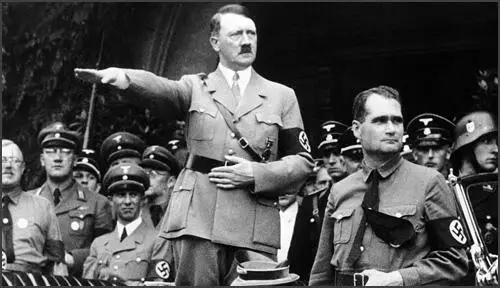
On this day in 2016, a letter, signed by nearly 50 well-known women, appeared in The Daily Telegraph, calling for a statue of Millicent Garrett Fawcett. It stated: "In Parliament Square, outside the home of one of the world’s oldest democracies, stand eleven statues. Not a single one of these statues is of a woman." The letter goes on to state that "In two years time, it will be nearly 100 years since women won the argument that our sex does not render us incapable of participating in the running of our country. Nearly a century has gone by, and yet Parliament Square continues to tell us that democracy is a man’s world. This needs to change - and now is the time to start working on that. The women who fought for our rights - the suffragettes - deserve to be commemorated in front of the building they were locked out of for centuries."
In fact, the suffragettes were recognised when a statue of Emmeline Pankhurst was erected in Victoria Tower Gardens, close to the Sovereign’s Entrance of the Houses of Parliament. It was unveiled in 1930 and in 1958, a bronze relief commemorating Christabel Pankhurst was added. It is in fact, the suffragists, who numbered over 100,000, compared to the 2,000 suffragettes, who have not been recognised.
On 2nd April 2017 it was announced that a statue of Millicent Garrett Fawcett was to be erected in Parliament Square outside the Palace of Westminster, and will become the first statue of a woman to appear there. Sam Smethers, chief executive of the Fawcett Society, which is named in Millicent’s honour and campaigns for greater representation of women in public life, said: "Her contribution was great but she has been overlooked and unrecognised until now. By honouring her we also honour the wider suffrage movement.”
The statue of Millicent Garrett Fawcett was unveiled on 24th April 2018 It joined the eleven men in Parliament Square. This includes statues of Robert Peel, George Canning, Henry John Temple, 3rd Viscount Palmerston, Edward Smith-Stanley, 14th Earl of Derby, Benjamin Disraeli, David Lloyd George and Winston Churchill. Seven men who during their political careers did what they could to stop women getting the vote.
